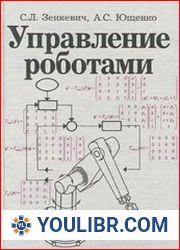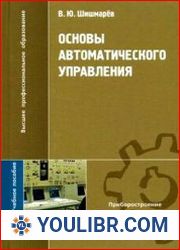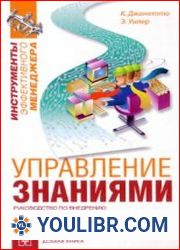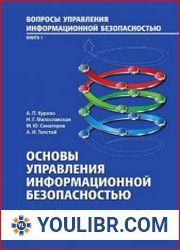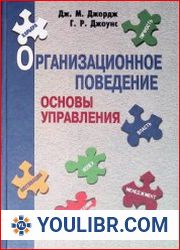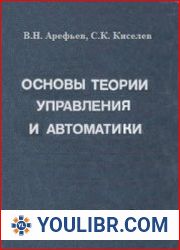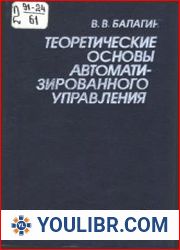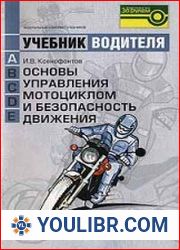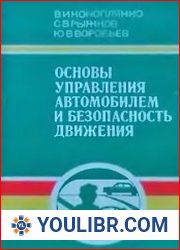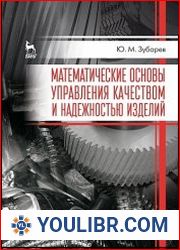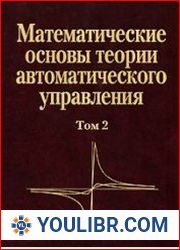
BOOKS - TECHNICAL SCIENCES - Управление роботами основы управления манипуляционными р...

Управление роботами основы управления манипуляционными роботами
Author: Зенкевич С.Л., Ющенко А.С.
Year: 2000
Format: PDF
File size: 11 MB
Year: 2000
Format: PDF
File size: 11 MB
The questions of the theory of manipulative robots and methods of their control are systematically presented. Basic kinematic relations are considered, which make it possible to determine position of robot manipulating mechanism in working space, as well as to solve problems on speeds and accelerations of movement of its links. Methods and algorithms of manipulator kinematic control are described in detail.
يستكشف كتاب «التحكم في الروبوت: أساسيات التحكم في التلاعب» الجوانب الأساسية للروبوتات ونظرية التحكم، مما يوفر للقراء فهمًا شاملاً للمبادئ والطرق التي ينطوي عليها التحكم في الروبوتات. مع استمرار تقدم التكنولوجيا بوتيرة غير مسبوقة، من الأهمية بمكان أن يطور الناس نموذجًا شخصيًا لفهم العملية التكنولوجية لتطوير المعرفة الحديثة. وسيكون هذا النموذج أساسا لبقاء البشرية ووحدة الشعوب في عالم مليء بالصراعات والانقسامات. يبدأ الكتاب بفحص العلاقات الحركية الأساسية التي تتحكم في حركة الروبوتات وآلياتها، مما يمكّن القراء من تحديد موقع آلية التلاعب بالروبوت في مساحة العمل وحل المشكلات المرتبطة بسرعات وتسارع الحركة. من هناك، يتعمق النص في تعقيدات طرق وخوارزميات التحكم الحركي المتلاعب، ويقدم أوصافًا مفصلة لتقنيات مختلفة وتطبيقاتها. أحد الاتجاهات الرئيسية للكتاب هو الحاجة إلى دراسة وفهم تطور التكنولوجيا، لأن هذا الفهم هو الذي سيسمح للناس باستخدام إمكانيات الروبوتات لتحسين المجتمع. ويشدد المؤلف على أهمية الاعتراف بالترابط بين جميع الأشياء وإمكانية أن تتسبب التكنولوجيا في نتائج إيجابية وسلبية. بمجرد أن نفهم المبادئ الأساسية للتكنولوجيا، يمكننا استخدامها لخلق مستقبل أكثر انسجامًا واستدامة. libro «Gestión de robots: fundamentos del control de manipulación» explora aspectos básicos de la robótica y la teoría del control, proporcionando a los lectores una comprensión integral de los principios y técnicas relacionados con el control de robots. A medida que la tecnología continúa evolucionando a un ritmo sin precedentes, es fundamental que las personas desarrollen un paradigma personal para comprender el proceso tecnológico de desarrollo del conocimiento moderno. Este paradigma servirá de base para la supervivencia de la humanidad y la unidad de los seres humanos en un mundo lleno de conflictos y divisiones. libro comienza con el estudio de las relaciones cinemáticas fundamentales que controlan el movimiento de los robots y sus mecanismos, permitiendo a los lectores determinar la posición del mecanismo de manipulación del robot en el espacio de trabajo y resolver los problemas relacionados con las velocidades y aceleraciones del movimiento. A partir de ahí, el texto profundiza en las sutilezas de los métodos y algoritmos de control cinemático de los manipuladores, ofreciendo descripciones detalladas de las diferentes técnicas y sus aplicaciones. Una de las principales líneas del libro es la necesidad de estudiar y entender la evolución de la tecnología, ya que es esa comprensión la que permitirá a las personas aprovechar las capacidades de la robótica para mejorar la sociedad. autor subraya la importancia de reconocer la interconexión de todas las cosas y la posibilidad de que la tecnología provoque efectos tanto positivos como negativos. Conscientes de los principios fundamentales de la tecnología, podemos utilizarlos para crear un futuro más armónico y sostenible. 「機器人控制:操縱控制的基礎」一書探討了機器人技術和控制理論的基本方面,使讀者全面了解與機器人控制有關的原則和方法。隨著技術繼續以前所未有的速度發展,人們必須發展個人範式,以了解現代知識發展的技術過程。這種模式將成為人類生存和人類團結的基礎,在這個充滿沖突和分裂的世界中。本書首先研究控制機器人運動的基本運動學關系,使讀者能夠確定機器人操縱機制在工作空間中的位置,並解決與運動速度和加速有關的問題。從那裏開始,文本深入研究了操縱器運動控制方法和算法的復雜性,為各種技術及其應用提供了詳細的描述。該書的主要重點之一是需要研究和理解技術的發展,因為正是這種理解將使人們能夠利用機器人技術的能力來改善社會。作者強調認識到所有事物的相互聯系以及技術產生正面和負面影響的可能性的重要性。通過了解技術的基本原則,我們可以利用它們創造一個更加和諧和可持續的未來。
O livro «Gestão de robôs: base de gestão de manipulação» explora os principais aspectos da robótica e da teoria de controle, oferecendo aos leitores uma compreensão completa dos princípios e métodos relacionados com o controle de robôs. Como a tecnologia continua a evoluir a um ritmo sem precedentes, é essencial que as pessoas desenvolvam um paradigma pessoal para compreender o processo tecnológico de desenvolvimento do conhecimento moderno. Este paradigma servirá de base para a sobrevivência da humanidade e da unidade das pessoas em um mundo cheio de conflitos e divisões. O livro começa com o estudo de relações cinemáticas fundamentais que controlam o movimento dos robôs e seus mecanismos, permitindo que os leitores identifiquem a posição do mecanismo de manipulação do robô no espaço de trabalho e resolvam os problemas de velocidade e aceleração do movimento. A partir daí, o texto é aprofundado na sutileza dos métodos e algoritmos de controle cinemático de manipuladores, oferecendo descrições detalhadas de diferentes técnicas e seus aplicativos. Um dos eixos principais do livro é a necessidade de explorar e compreender a evolução da tecnologia, porque é essa compreensão que permitirá que as pessoas aproveitem as capacidades da robótica para melhorar a sociedade. O autor ressalta a importância de reconhecer a interconexão entre todas as coisas e a possibilidade de a tecnologia causar efeitos positivos e negativos. Ao reconhecermos os princípios fundamentais da tecnologia, podemos usá-los para criar um futuro mais harmonioso e sustentável. "Robot Kontrolü: Manipülasyon Kontrolünün Temelleri" kitabı, robotik ve kontrol teorisinin temel yönlerini araştırıyor ve okuyuculara robot kontrolünde yer alan ilke ve yöntemleri kapsamlı bir şekilde anlamalarını sağlıyor. Teknoloji benzeri görülmemiş bir hızda ilerlemeye devam ettikçe, insanların modern bilgiyi geliştirmenin teknolojik sürecini anlamak için kişisel bir paradigma geliştirmeleri çok önemlidir. Bu paradigma, insanlığın hayatta kalması ve çatışmalar ve bölünmelerle dolu bir dünyada insanların birliği için temel olarak hizmet edecektir. Kitap, robotların hareketini ve mekanizmalarını kontrol eden temel kinematik ilişkileri inceleyerek, okuyucuların robotun manipülasyon mekanizmasının çalışma alanındaki konumunu belirlemelerini ve hızlar ve hareket hızları ile ilgili sorunları çözmelerini sağlayarak başlar. Buradan, metin, manipülatör kinematik kontrol yöntemlerinin ve algoritmalarının inceliklerini inceler ve çeşitli tekniklerin ve uygulamalarının ayrıntılı açıklamalarını sunar. Kitabın ana yönlerinden biri, teknolojinin evrimini inceleme ve anlama ihtiyacıdır, çünkü insanların toplumu iyileştirmek için robotik olanaklarını kullanmalarını sağlayacak olan bu anlayıştır. Yazar, her şeyin birbirine bağlılığını ve teknolojinin hem olumlu hem de olumsuz sonuçlara neden olma potansiyelini tanımanın önemini vurgulamaktadır. Teknolojinin altında yatan ilkeleri anladığımızda, bunları daha uyumlu ve sürdürülebilir bir gelecek yaratmak için kullanabiliriz. "Robot Control: Fundamentals of Manipulation Control'という本では、ロボット工学と制御理論の基本的な側面を探求し、ロボット制御に関わる原理と方法についての包括的な理解を読者に提供しています。テクノロジーが前例のないペースで進歩し続ける中で、人々が現代の知識を開発する技術プロセスを理解するための個人的なパラダイムを開発することが重要です。このパラダイムは、紛争と分裂に満ちた世界における人類の存続と人々の団結の基盤となるでしょう。まずは、ロボットの動きとそのメカニズムを制御する基本的なキネマティックな関係を調べ、ワークスペースにおけるロボットの操作メカニズムの位置を決定し、速度や動きの加速に伴う問題を解決することから始まります。そこから、テキストは、様々な技術とそのアプリケーションの詳細な説明を提供し、マニピュレータのキネマティック制御方法とアルゴリズムの複雑さを掘り下げます。この本の主な方向の1つは、ロボット工学の可能性を人々が社会を改善するために使用できるようにするのはこの理解であるため、技術の進化を研究し理解する必要があることです。著者は、すべてのものの相互接続性を認識することの重要性と、テクノロジーがプラスとマイナスの両方の結果を引き起こす可能性を強調しています。技術の根底にある原則を理解すれば、より調和のとれた持続可能な未来を創造するためにそれらを使用することができます。 Książka „Kontrola robotów: podstawy kontroli manipulacji” bada podstawowe aspekty robotyki i teorii kontroli, zapewniając czytelnikom kompleksowe zrozumienie zasad i metod związanych z kontrolą robotów. Ponieważ technologia nadal rozwija się w bezprecedensowym tempie, dla ludzi kluczowe jest opracowanie osobistego paradygmatu dla zrozumienia technologicznego procesu rozwoju nowoczesnej wiedzy. Paradygmat ten będzie stanowił podstawę przetrwania ludzkości i jedności ludzi w świecie pełnym konfliktów i podziałów. Książka rozpoczyna się badaniem podstawowych relacji kinematycznych, które kontrolują ruch robotów i ich mechanizmów, umożliwiając czytelnikom określenie pozycji mechanizmu manipulacji robotem w przestrzeni roboczej oraz rozwiązywanie problemów związanych z prędkością i przyspieszeniami ruchu. Stamtąd tekst zagłębia się w zawiłości manipulatorów kinematycznych metod kontroli i algorytmów, oferując szczegółowe opisy różnych technik i ich zastosowań. Jednym z głównych kierunków książki jest potrzeba studiowania i zrozumienia ewolucji technologii, ponieważ to właśnie to zrozumienie pozwoli ludziom wykorzystać możliwości robotyki do poprawy społeczeństwa. Autor podkreśla znaczenie uznania wzajemnych powiązań wszystkich rzeczy i możliwości, jakie technologia może wywołać zarówno pozytywne, jak i negatywne konsekwencje. Kiedy już zrozumiemy podstawowe zasady technologii, możemy wykorzystać je do stworzenia bardziej harmonijnej i zrównoważonej przyszłości. Книга «Управление роботами: основы управления манипуляциями» исследует основные аспекты робототехники и теории управления, предоставляя читателям всестороннее понимание принципов и методов, связанных с управлением роботами. Поскольку технологии продолжают развиваться беспрецедентными темпами, для людей крайне важно разработать личную парадигму для понимания технологического процесса развития современных знаний. Эта парадигма послужит фундаментом для выживания человечества и единства людей в мире, наполненном конфликтами и разделениями. Книга начинается с изучения фундаментальных кинематических отношений, которые управляют движением роботов и их механизмов, давая возможность читателям определить положение манипуляционного механизма робота в рабочем пространстве и решить проблемы, связанные со скоростями и ускорениями движения. Оттуда текст углубляется в тонкости методов и алгоритмов кинематического управления манипуляторами, предлагая подробные описания различных техник и их приложений. Одним из основных направлений книги является необходимость изучения и понимания эволюции технологий, поскольку именно это понимание позволит людям использовать возможности робототехники для улучшения общества. Автор подчеркивает важность признания взаимосвязанности всех вещей и возможности для технологий вызывать как положительные, так и отрицательные последствия. Осознав основополагающие принципы технологии, мы можем использовать их для создания более гармоничного и устойчивого будущего. הספר "Robot Control: Fundmentals of Manipulation Control'חוקר היבטים בסיסיים של רובוטיקה ותיאורית בקרה, ומספק לקוראים הבנה מקיפה של העקרונות והשיטות הכרוכות בשליטה על רובוטים. ככל שהטכנולוגיה ממשיכה להתקדם בקצב חסר תקדים, חיוני שאנשים יפתחו פרדיגמה אישית להבנת התהליך הטכנולוגי של פיתוח ידע מודרני. פרדיגמה זו תשמש בסיס להישרדות האנושות ולאחדות האנשים בעולם מלא בסכסוכים ופילוגים. הספר מתחיל בבדיקת מערכות היחסים הקינמטיות הבסיסיות השולטות על תנועת הרובוטים והמנגנונים שלהם, ומאפשר לקוראים לקבוע את מיקום מנגנון המניפולציה של הרובוט במרחב העבודה ולפתור בעיות הקשורות למהירויות ותאוצות התנועה. משם, הטקסט מתעמק לתוך המורכבות של שיטות בקרה קינמטיביות מניפולטור ואלגוריתמים, מציע תיאורים מפורטים של טכניקות שונות ויישומים שלהם. אחד הכיוונים העיקריים של הספר הוא הצורך ללמוד ולהבין את התפתחות הטכנולוגיה, מכיוון שזו ההבנה שתאפשר לאנשים להשתמש באפשרויות של רובוטיקה כדי לשפר את החברה. המחבר מדגיש את החשיבות של הכרה בקישוריות של כל הדברים והפוטנציאל של הטכנולוגיה לגרום הן לתוצאות חיוביות והן לשליליות. ברגע שנבין את העקרונות הבסיסיים של הטכנולוגיה, נוכל להשתמש בהם כדי ליצור עתיד הרמוני ובר קיימא יותר. livre « La gestion des robots : les bases de la gestion de la manipulation » explore les principaux aspects de la robotique et de la théorie du contrôle, fournissant aux lecteurs une compréhension complète des principes et des méthodes liés à la gestion des robots. Alors que la technologie continue d'évoluer à un rythme sans précédent, il est essentiel que les gens élaborent un paradigme personnel pour comprendre le processus technologique du développement des connaissances modernes. Ce paradigme servira de base à la survie de l'humanité et à l'unité des hommes dans un monde rempli de conflits et de divisions. livre commence par étudier les relations cinématiques fondamentales qui contrôlent le mouvement des robots et leurs mécanismes, ce qui permet aux lecteurs de déterminer la position du mécanisme de manipulation du robot dans l'espace de travail et de résoudre les problèmes liés aux vitesses et aux accélérations du mouvement. De là, le texte s'enfonce dans les subtilités des techniques et algorithmes de gestion cinématique des manipulateurs, offrant des descriptions détaillées des différentes techniques et de leurs applications. L'un des principaux domaines du livre est la nécessité d'étudier et de comprendre l'évolution des technologies, car c'est cette compréhension qui permettra aux gens d'utiliser les possibilités de la robotique pour améliorer la société. L'auteur souligne qu'il importe de reconnaître l'interdépendance de toutes les choses et la possibilité pour la technologie de produire des effets positifs et négatifs. En réalisant les principes fondamentaux de la technologie, nous pouvons les utiliser pour créer un avenir plus harmonieux et durable. Das Buch „Robotersteuerung: Grundlagen der Manipulationssteuerung“ untersucht grundlegende Aspekte der Robotik und der Steuerungstheorie und vermittelt den sern ein umfassendes Verständnis der Prinzipien und Methoden der Robotersteuerung. Da sich die Technologie in einem beispiellosen Tempo weiterentwickelt, ist es für die Menschen von entscheidender Bedeutung, ein persönliches Paradigma zu entwickeln, um den technologischen Prozess der Entwicklung des modernen Wissens zu verstehen. Dieses Paradigma wird als Grundlage für das Überleben der Menschheit und die Einheit der Menschen in einer Welt voller Konflikte und Spaltungen dienen. Das Buch beginnt mit der Untersuchung der grundlegenden kinematischen Beziehungen, die die Bewegung der Roboter und ihrer Mechanismen steuern, und ermöglicht es den sern, die Position des Manipulationsmechanismus des Roboters im Arbeitsraum zu bestimmen und Probleme im Zusammenhang mit den Geschwindigkeiten und Beschleunigungen der Bewegung zu lösen. Von dort aus taucht der Text in die Feinheiten der Methoden und Algorithmen der kinematischen Steuerung der Manipulatoren ein und bietet detaillierte Beschreibungen der verschiedenen Techniken und ihrer Anwendungen. Einer der Hauptschwerpunkte des Buches ist die Notwendigkeit, die Entwicklung der Technologie zu untersuchen und zu verstehen, da es dieses Verständnis ist, das es den Menschen ermöglicht, die Möglichkeiten der Robotik zu nutzen, um die Gesellschaft zu verbessern. Der Autor betont, wie wichtig es ist, die Vernetzung aller Dinge zu erkennen und der Technologie die Möglichkeit zu geben, sowohl positive als auch negative Auswirkungen zu haben. Wenn wir die grundlegenden Prinzipien der Technologie erkennen, können wir sie nutzen, um eine harmonischere und nachhaltigere Zukunft zu schaffen. Il libro «Gestione dei robot: basi di controllo della manipolazione» esplora gli aspetti fondamentali della robotica e della teoria del controllo, fornendo ai lettori un'ampia comprensione dei principi e dei metodi legati alla gestione dei robot. Poiché la tecnologia continua a crescere a un ritmo senza precedenti, è fondamentale per le persone sviluppare un paradigma personale per comprendere il processo tecnologico di sviluppo della conoscenza moderna. Questo paradigma sarà la base per la sopravvivenza dell'umanità e dell'unità delle persone in un mondo pieno di conflitti e divisioni. Il libro inizia esplorando le relazioni cinematiche fondamentali che controllano il movimento dei robot e i loro meccanismi, permettendo ai lettori di identificare la posizione del meccanismo di manipolazione del robot nello spazio di lavoro e risolvere i problemi di velocità e accelerazione del movimento. Da lì il testo viene approfondito nella finezza dei metodi e algoritmi di gestione cinematica dei manipolatori, offrendo descrizioni dettagliate delle diverse tecniche e delle loro applicazioni. Uno dei punti principali del libro è la necessità di studiare e comprendere l'evoluzione della tecnologia, perché questa comprensione consentirà alle persone di sfruttare le opportunità della robotica per migliorare la società. L'autore sottolinea l'importanza di riconoscere l'interconnessione tra tutte le cose e la possibilità per la tecnologia di generare effetti sia positivi che negativi. Una volta riconosciuti i principi fondanti della tecnologia, possiamo usarli per creare un futuro più armonioso e sostenibile. The book "Management of Robots: Fundamentals of Manipulation Control" explores the essential aspects of robotics and control theory, providing readers with a comprehensive understanding of the principles and techniques involved in managing and controlling robots. As technology continues to evolve at an unprecedented pace, it is crucial for humans to develop a personal paradigm for understanding the technological process of developing modern knowledge. This paradigm will serve as the foundation for the survival of humanity and the unity of people in a world filled with conflict and division. The book begins by examining the fundamental kinematic relations that govern the movement of robots and their mechanisms, enabling readers to determine the position of the robot's manipulating mechanism in the working space and solve problems related to speeds and accelerations of movement. From there, the text delves into the intricacies of manipulator kinematic control methods and algorithms, offering detailed descriptions of various techniques and their applications. One of the primary focuses of the book is the need to study and understand the evolution of technology, as it is this understanding that will allow humans to harness the power of robotics for the betterment of society. The author emphasizes the importance of recognizing the interconnectedness of all things and the potential for technology to bring about both positive and negative consequences. By grasping the underlying principles of technology, we can use it to create a more harmonious and sustainable future. "Robot Control: Fundamentals of Manipulation Control" 책은 로봇 및 제어 이론의 기본 측면을 탐색하여 독자에게 로봇 제어와 관련된 원리와 방법에 대한 포괄적 인 이해를 제공합니다. 기술이 전례없는 속도로 계속 발전함에 따라 사람들은 현대 지식을 개발하는 기술 프로세스를 이해하기위한 개인 패러다임을 개발하는 것이 중요합니다. 이 패러다임은 인류의 생존과 갈등과 분열로 가득 찬 세상에서 사람들의 연합을위한 기초가 될 것입니다. 이 책은 로봇의 움직임과 메커니즘을 제어하는 기본적인 운동 학적 관계를 검토하여 독자가 작업 공간에서 로봇의 조작 메커니즘의 위치를 결정하고 속도 및 움직임 가속과 관련된 문제를 해결할 수 있도록합니다. 여기에서 텍스트는 조작자 운동 학적 제어 방법 및 알고리즘의 복잡성을 탐구하여 다양한 기술과 응용 프로그램에 대한 자세한 설명을 제공합니다. 이 책의 주요 방향 중 하나는 사람들이 사회를 개선하기 위해 로봇 공학의 가능성을 사용할 수있게하는 것이 이러한 이해이기 때문에 기술의 진화를 연구하고 이해해야한다는 것입니다. 저자는 모든 것의 상호 연결성을 인식하는 것의 중요성과 기술이 긍정적 인 결과와 부정적인 결과를 초래할 가능성을 강조합니다. 기술의 기본 원칙을 이해하면 기술을 사용하여보다 조화롭고 지속 가능한 미래를 만들 수 있습니다. download pdf file Управление роботами основы управления манипуляционными роботами descarregar ficheiro pdf Controlar robôs de base de controle de robôs manipuladores Scarica il file pdf Gestione robot base controllo robot manipolazione להוריד קובץ PDF בקרת רובוטים יסודות של שליטה מניפולטיבית ברובוטים download pdf file pdf 파일 다운로드 télécharger le fichier pdf Gestion des robots Base de gestion des robots de manipulation PDF-Datei herunterladen Robotersteuerung Grundlagen der Steuerung von Handhabungsrobotern descargar archivo pdf Control de robots básicos Control de robots manipuladores تنزيل ملف pdf أساسيات التحكم في الروبوت للتحكم في الروبوت المتلاعب скачать файл PDF Управление роботами основы управления манипуляционными роботами PDFファイルをダウンロード 下载 pdf 文件 機器人控制操縱機器人控制基礎
pobierz plik pdf Sterowanie robotem Podstawy manipulacyjnej kontroli robotów pdf dosyasını indir Robot Kontrolü Manipülatif Robot Kontrolünün Temelleri
Fragen der Theorie der Manipulationsroboter und Methoden ihrer Steuerung werden systematisch dargelegt. Die wichtigsten kinematischen Beziehungen, die es ermöglichen, die Position des Manipulationsmechanismus des Roboters im Arbeitsraum zu bestimmen und Probleme mit den Geschwindigkeiten und Beschleunigungen der Bewegung seiner Verbindungen zu lösen, werden berücksichtigt. Verfahren und Algorithmen zur kinematischen Steuerung von Manipulatoren werden ausführlich beschrieben.
Se esbozan sistemáticamente las cuestiones de la teoría de los robots manipuladores y los métodos de control de los mismos. Se han considerado las principales relaciones cinemáticas que permiten determinar la posición del mecanismo de manipulación del robot en el espacio de trabajo, así como resolver problemas sobre las velocidades y aceleraciones del movimiento de sus eslabones. Se detallan los métodos y algoritmos para el control cinemático de los manipuladores.
A teoria dos robôs manipuladores e as técnicas de controle são sistematicamente expostas. As principais relações cinemáticas são consideradas para determinar a posição do mecanismo de manipulação do robô no espaço de trabalho, além de lidar com os desafios de velocidade e aceleração dos seus eixos. Os métodos e algoritmos de controle cinematográfico de manipuladores são detalhados.
Les questions de la théorie des robots de manipulation et les méthodes de gestion sont systématiquement décrites. Les principales relations cinématiques permettant de déterminer la position du mécanisme de manipulation du robot dans l'espace de travail et de résoudre les problèmes de vitesse et d'accélération du mouvement de ses maillons ont été examinées. Les procédés et algorithmes de commande cinématique des manipulateurs sont décrits en détail.
Систематически изложены вопросы теории манипуляционных роботов и методы управления ими. Рассмотрены основные кинематические соотношения, позволяющие определять положение манипуляционного механизма робота в рабочем пространстве, а также решать задачи о скоростях и ускорениях движения его звеньев. Подробно описаны способы и алгоритмы кинематического управления манипуляторами.
The questions of the theory of manipulative robots and methods of their control are systematically presented. Basic kinematic relations are considered, which make it possible to determine position of robot manipulating mechanism in working space, as well as to solve problems on speeds and accelerations of movement of its links. Methods and algorithms of manipulator kinematic control are described in detail.
Sono sistematicamente esposti i problemi della teoria dei robot manipolatori e le tecniche di gestione. Sono state esaminate le principali relazioni cinematiche che consentono di determinare la posizione del meccanismo di manipolazione del robot nello spazio di lavoro e di affrontare le sfide relative alla velocità e all'accelerazione del movimento. Sono descritti in dettaglio i metodi e gli algoritmi di gestione cinematica dei manipolatori.
Fragen der Theorie der Manipulationsroboter und Methoden ihrer Steuerung werden systematisch dargelegt. Die wichtigsten kinematischen Beziehungen, die es ermöglichen, die Position des Manipulationsmechanismus des Roboters im Arbeitsraum zu bestimmen und Probleme mit den Geschwindigkeiten und Beschleunigungen der Bewegung seiner Verbindungen zu lösen, werden berücksichtigt. Verfahren und Algorithmen zur kinematischen Steuerung von Manipulatoren werden ausführlich beschrieben.
Se esbozan sistemáticamente las cuestiones de la teoría de los robots manipuladores y los métodos de control de los mismos. Se han considerado las principales relaciones cinemáticas que permiten determinar la posición del mecanismo de manipulación del robot en el espacio de trabajo, así como resolver problemas sobre las velocidades y aceleraciones del movimiento de sus eslabones. Se detallan los métodos y algoritmos para el control cinemático de los manipuladores.
A teoria dos robôs manipuladores e as técnicas de controle são sistematicamente expostas. As principais relações cinemáticas são consideradas para determinar a posição do mecanismo de manipulação do robô no espaço de trabalho, além de lidar com os desafios de velocidade e aceleração dos seus eixos. Os métodos e algoritmos de controle cinematográfico de manipuladores são detalhados.
Les questions de la théorie des robots de manipulation et les méthodes de gestion sont systématiquement décrites. Les principales relations cinématiques permettant de déterminer la position du mécanisme de manipulation du robot dans l'espace de travail et de résoudre les problèmes de vitesse et d'accélération du mouvement de ses maillons ont été examinées. Les procédés et algorithmes de commande cinématique des manipulateurs sont décrits en détail.
Систематически изложены вопросы теории манипуляционных роботов и методы управления ими. Рассмотрены основные кинематические соотношения, позволяющие определять положение манипуляционного механизма робота в рабочем пространстве, а также решать задачи о скоростях и ускорениях движения его звеньев. Подробно описаны способы и алгоритмы кинематического управления манипуляторами.
The questions of the theory of manipulative robots and methods of their control are systematically presented. Basic kinematic relations are considered, which make it possible to determine position of robot manipulating mechanism in working space, as well as to solve problems on speeds and accelerations of movement of its links. Methods and algorithms of manipulator kinematic control are described in detail.
Sono sistematicamente esposti i problemi della teoria dei robot manipolatori e le tecniche di gestione. Sono state esaminate le principali relazioni cinematiche che consentono di determinare la posizione del meccanismo di manipolazione del robot nello spazio di lavoro e di affrontare le sfide relative alla velocità e all'accelerazione del movimento. Sono descritti in dettaglio i metodi e gli algoritmi di gestione cinematica dei manipolatori.







